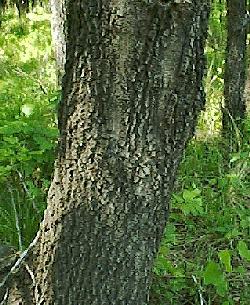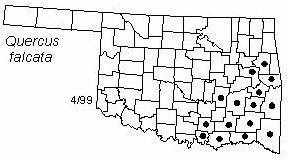

Tree to 25 m (80 ft) tall and 1 m (3 ft) diameter, with rounded open crown. Bark dark gray, rough, furrowed into broad plates and ridges on trunks and large branches. Twigs thick, rusty hairy in spring, becoming shiny brown later, ending in a cluster of small pointed reddish brown buds. Leaves alternate, elliptical, deeply divided into a long narrow end lobe and several usually curved side lobes each with 1-3 bristle tipped teeth, base usually irregular, 10-20 cm (4-8 in) long, shiny green above, gray- or rusty-soft hairy below, turning brown in fall. Fruits are acorns maturing in the second year, 12-15 mm (0.5-0.6 in) long, with scaly cup covering about 1/3.
Distribution: Native to about the southeastern quarter of the United States.
Habitat: well-drained bottomland forests and mesic upland forests.
Comment: An important timber tree, furnishing high-quality red oak lumber. Quercus is the ancient classical name for the European oaks; falcata refers to the often scythe-shaped leaves.
NWI status: FACU
Distribution in Oklahoma: 
BACK
NEXT
RETURN TO INDEX
Last update: 9/16/99
 Go to Oklahoma Biological Survey Home Page
Go to Oklahoma Biological Survey Home Page
 Disclaimer
Disclaimer